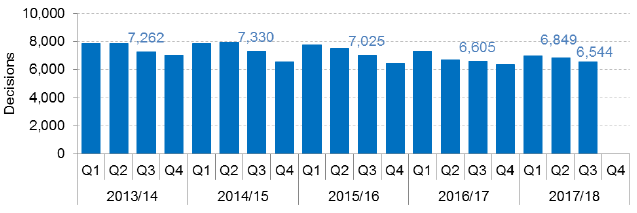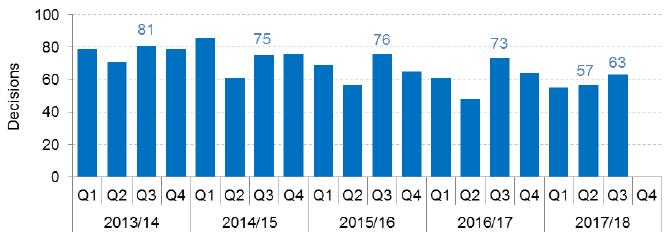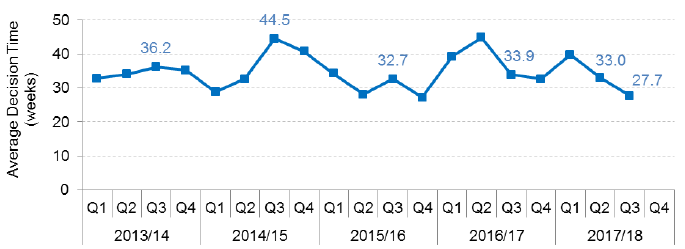Planning performance statistics: third quarter 2017-2018
This report presents the latest summary statistics on planning, decision-making, and timescales for October to December 2017 (quarter 3).
Planning Performance Statistics, 2017/18, Q3
This report presents the latest summary statistics on planning application decision-making and timescales for October to December 2017 (Quarter 3), as well as historic data going back to quarter one of 2013/14. It is based on data collected by the Scottish Government from Local and Planning Authorities as part of the Planning Performance Framework (introduced in 2012).
Applications for Local Developments (excludes legacy cases)
There were 6,544 applications for local developments decided in quarter three of 2017/18, 305 (4.5 per cent) fewer than the 6,849 decisions in the previous quarter, and 61 (0.9 per cent) fewer applications than the 6,605 decisions in quarter three of 2016/17. The average decision time for these 6,544 local developments was 9.1 weeks, less than a day slower compared to the previous quarter (9.0 weeks), but slightly quicker than the equivalent quarter (9.5 weeks) in 2016/17.
Chart 1: Applications for Local Developments: Number of decisions

Chart 2: Applications for Local Developments: Average decision time (weeks)

Some of the changes over time seen in the decision times may be partly due to improvements in recording of periods of inaction by the applicant. This is referred to as “stopping the clock”. See Section 9 for further details.
In addition, there were 429 local development applications concluded in quarter three of 2017/18 that were subject to separate processing agreements and are not included in average time calculations. 74.8 per cent of these applications met the agreed timescales that had been set between developers and local authorities.
Applications for Major Developments (excludes legacy cases)
For applications subject to average time calculations there were 63 major developments decided in quarter three of 2017/18, 6 (10.5 per cent) more than the 57 decisions in the previous quarter, and 10 (13.7 per cent) fewer than the 73 decisions in the equivalent quarter of 2016/17. The average decision time for these 63 major developments was 27.7 weeks, more than five weeks quicker than the previous quarter (33.0 weeks) and quicker by just over six weeks compared to the equivalent quarter three figure (33.9 weeks) in 2016/17.
Chart 3: Applications for Major Developments: Number of decisions

Chart 4: Applications for Major Developments: Average decision time (weeks)

The average time figure of 27.7 weeks has been influenced by a number of lengthier decision times, including nine decision times that each took longer than a year.
Further information on the distribution of decision times for major development applications is given in Annex A.
Some of the changes over time seen in the decision times may be partly due to improvements in recording of periods of inaction by the applicant. This is referred to as “stopping the clock”. See Section 9 for further details.
In addition there were a further 21 major development applications concluded in quarter three of 2017/18 that were subject to separate processing agreements. 76.2 per cent of these applications met agreed timescales that had been set between developers and local authorities. Applications subject to processing agreements are not included in average time calculations. For the most recent quarter, major applications with processing agreements accounted for a quarter of the decisions made for all major developments. When processing agreements are included there is little change in the total number of decisions made in the first three quarters of 2017/18 - 81, 80 and 84.
There was also one Major Development pre 3rd August 2009 legacy case. Further details about legacy cases can be seen in Section 10.
Contact
There is a problem
Thanks for your feedback